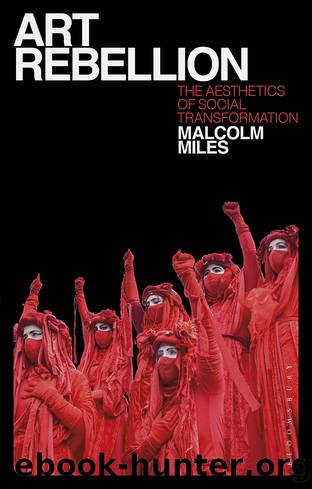Art Rebellion by Malcolm Miles;

Author:Malcolm Miles;
Language: eng
Format: epub
Publisher: Bloomsbury UK
PART THREE
Critical practices
Chapter 6
After the statues
In Chapter 5, I investigated how culture represented the Holocaust, finding that while the conventional form of the public monument was inadequate to bear the burden of extreme history, alternative forms had emerged, while literature achieved a stretching of language to breaking point. In this chapter, I return to the problem of public representation, but looking at a wider history, beginning with the toppling of a statue of slave trader and philanthropist Edward Colston in Bristol in 2020. Public monuments, as a general category, represent the values which a society is required to maintain, personified by individuals to whom, where a plinth is used, members of diverse publics are required literally to look up. One question is whether the monument, as a formal type, is too integral to this relation of power-over to be able to carry alternative meanings. Another is whether the removal of statues is a legitimate act of social reformation (as happened, for instances, in Ireland during the struggle for independence, and in the East bloc after the end of state socialism in 1989). This leads to a further question, as to what else might appear in the public realm â which is by no means limited to public spaces â to convey the contested values of a democratic society of diverse publics today. But I begin in Bristol.
Statues
A bronze statue of Edward Colston (1636â1721), designed by Irish sculptor John Cassidy, was erected in the centre of Bristol in 1895. While the figure is rendered conventionally in a neo-classical style, with flowing robes and a long wig, the plinth is supported by four dolphins in the Art Nouveau style of the 1890s. A plaque claims that Colston was a virtuous son of the city. In June 2020, the statue was pulled down by Black Lives Matter demonstrators and thrown into the river Avon in the nearby Harbourside district. Since then, Colston Hall has been renamed Bristol Beacon and a Victorian stained glass window in his memory has been removed from the church of St Mary Redcliffe. At the time of writing, debate continues as to the statueâs future site, if it has one. One suggestion is that it be returned to the plinth in order to be toppled annually in a public festival. A majority opinion is that it be retained in a museum with suitable documentation of its history, contexts and demise. Of course, it could also be melted down and made into something else, such as street furniture.
Colstonâs statue has two histories: one as representing a local person in Bristol, the other as belonging to a general type of monument, among countless bronze likenesses of rich and powerful white men. This follows a proliferation of commemorative statues across Europe from the second half of the nineteenth century onwards. Many are now incidental, those whom they commemorate more or less forgotten unless brought to public attention by a new controversy. But there is also a recent, parallel genre of street-level figures, mainly from literature and popular culture.
Download
This site does not store any files on its server. We only index and link to content provided by other sites. Please contact the content providers to delete copyright contents if any and email us, we'll remove relevant links or contents immediately.
The remains of the day by Kazuo Ishiguro(8382)
Tools of Titans by Timothy Ferriss(7807)
Giovanni's Room by James Baldwin(6807)
The Black Swan by Nassim Nicholas Taleb(6761)
Inner Engineering: A Yogi's Guide to Joy by Sadhguru(6439)
The Way of Zen by Alan W. Watts(6288)
Asking the Right Questions: A Guide to Critical Thinking by M. Neil Browne & Stuart M. Keeley(5355)
The Power of Now: A Guide to Spiritual Enlightenment by Eckhart Tolle(5330)
The Six Wives Of Henry VIII (WOMEN IN HISTORY) by Fraser Antonia(5234)
Astrophysics for People in a Hurry by Neil DeGrasse Tyson(4998)
12 Rules for Life by Jordan B. Peterson(4160)
Housekeeping by Marilynne Robinson(4059)
The Ethical Slut by Janet W. Hardy(4036)
Skin in the Game by Nassim Nicholas Taleb(3965)
Double Down (Diary of a Wimpy Kid Book 11) by Jeff Kinney(3922)
Ikigai by Héctor García & Francesc Miralles(3889)
The Art of Happiness by The Dalai Lama(3844)
Skin in the Game: Hidden Asymmetries in Daily Life by Nassim Nicholas Taleb(3720)
Walking by Henry David Thoreau(3681)
